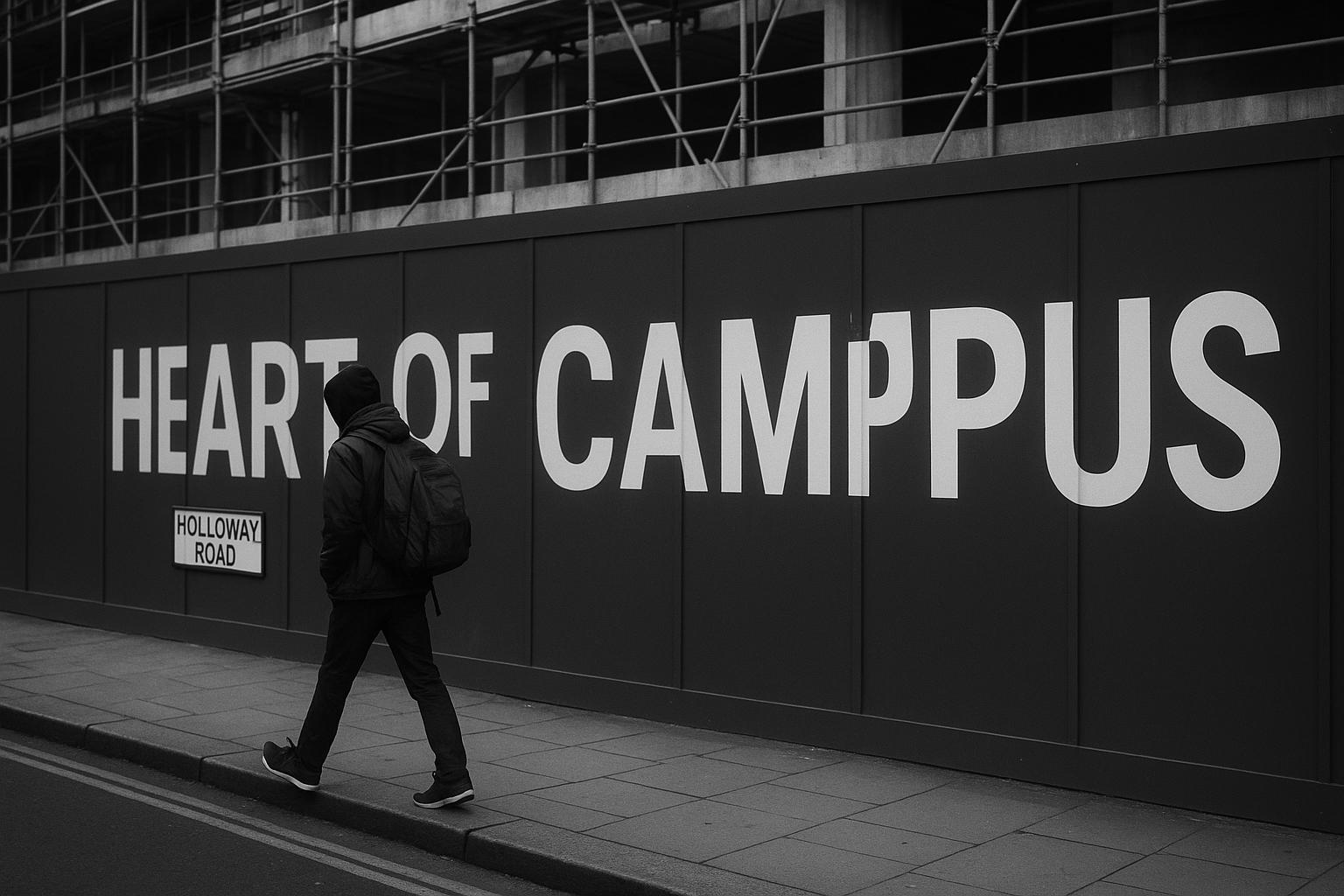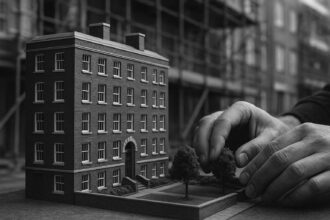After a period of financial and managerial upheaval, London Metropolitan University says it has stabilised and is investing in new courses, student support and a £150m Heart of the Campus programme — but contractor collapse, a smaller 2024 intake and a pending vice‑chancellor search mean the recovery is still unproven.
London Metropolitan University presents a study in contrasts: a civic, largely London‑based institution with a markedly diverse intake, but one still navigating the consequences of years of upheaval even as it prepares for an ambitious campus renaissance. According to the original profile, most students are taught at the Holloway Road campus in north London, with smaller presences in Shoreditch and Aldgate, and a ten‑year, £150 million estates programme is reshaping those sites ahead of a hoped‑for September 2026 handover of the main Heart of the Campus works. The university itself, however, cautions that the project has experienced disruption and that remedial arrangements are under way following the collapse of a contractor.
The financial and managerial reset that preceded the current phase of investment is credited to Professor Lynn Dobbs, who led the university as vice‑chancellor from 2018 until her retirement at the end of 2024. The university’s statement on her departure highlighted a period of recovery under her leadership—improvements in income, student outcomes and staff morale—and said a leadership search was being undertaken to secure continuity. The claim of a stabilised financial footing is central to London Met’s case for renewed growth, but the wider picture remains a work in progress.
Behind the headlines, the student body is large, mature and ethnically varied. University statistics show more than 14,000 UK‑based higher education students in 2023–24, with a high proportion of mature learners and a student population drawn from around 150 nationalities. The original profile notes that the September 2024 intake was the university’s smallest in a decade and that students of Black heritage were the largest single grouping in that cohort—facts that underline both London Met’s role as a gateway for under‑represented Londoners and the recruitment challenges still to be addressed.
Academic provision has been remodelled to widen access and link study closely to local and sectoral needs. The school of arts, architecture and design is due to operate across three sites from 2025–26, placing fine art, fashion and textiles in Shoreditch while situating photography and visual communications on the Holloway campus to encourage interdisciplinary working with digital and computing subjects. The university has also added foundation years to several built environment degrees from September 2025 and introduced new courses including building surveying, biomedical engineering, and artificial intelligence and robotics—routes that the institution frames as widening pipelines into professional careers. A growing health offering, including a recently introduced adult nursing programme and the addition of mental‑health nursing, further signals strategic curriculum expansion.
Financial support and student services figure prominently in London Met’s pitch to prospective applicants. The university publicises a central hardship pot—described in the profile as around £370,000—and a care‑leaver bursary of £1,500 a year, while directing students to national support schemes. Government guidance for 2025–26 confirms that means‑tested childcare grants will cover up to 85% of costs, capped at £199.62 per week for one child and £342.24 for two or more, and that the Adult Dependants’ Grant has a maximum entitlement for eligible students; the university points students to Student Services for help navigating eligibility and additional external funding. London Met also makes clear that it does not own student halls and that with roughly three‑quarters of its intake drawn from London many students live at home.
Support beyond finance is a continuing priority. The institution runs a permanent “Small Steps, Big Difference” wellbeing campaign and operates a Centre for Equity and Inclusion, while emphasising a mix of online, telephone and face‑to‑face counselling and safeguarding measures embedded across its academic schools. The university also offers free, anonymous peer‑to‑peer support through the TalkCampus app—a service it introduced in 2020—while reminding users that such tools are complementary to emergency services and professional clinical help.
The estates programme, marketed as the Heart of the Campus, is intended to provide not only new social and learning spaces but improved accessibility, integrated technology and sustainability features such as a living wall. The university’s estates update states that student and staff consultation has been integral to design thinking; it also candidly records that the project was set back by the collapse of contractor ISG and that negotiations are under way to appoint a replacement and to deliver an initial phase in summer 2025. That caveated timetable is the most immediate litmus test of whether the physical transformation will dovetail with the institutional recovery already claimed by senior managers.
London Met’s public materials and recent reporting combine to portray an institution rooted in widening participation and civic mission, which has stabilised after a bruising period and is now investing in both people and place. The university claims progress on recruitment, income and staff morale, but the smaller 2024 intake and the practical headwinds facing campus delivery are reminders that the recovery is not yet an assured story. The coming months—marked by campus works, course roll‑outs and a new vice‑chancellor search—are likely to determine whether the university’s ambitions translate into sustained momentum for its students and for the communities it serves.
 Reference Map:
Reference Map:
Reference Map:
- Paragraph 1 – [1], [2]
- Paragraph 2 – [3], [1]
- Paragraph 3 – [4], [1]
- Paragraph 4 – [1]
- Paragraph 5 – [1], [5], [6]
- Paragraph 6 – [1], [7]
- Paragraph 7 – [2], [1]
- Paragraph 8 – [1], [3], [2]
Source: Noah Wire Services
- https://www.dailymail.co.uk/news/university-guide/article-14914761/London-Metropolitan-University.html?ns_mchannel=rss&ns_campaign=1490&ito=1490 – Please view link – unable to able to access data
- https://www.londonmet.ac.uk/about/our-university/university-publications/estates-strategy/heart-of-the-campus/ – London Metropolitan University’s Heart of the Campus project describes a redevelopment of the Holloway Road campus to create a modern hub. The plan includes new flexible social and learning spaces, a redesigned main entrance and plaza, improved accessibility, integrated technology and sustainability features such as a living wall. An update notes an agreement with contractor ISG and explains that ISG’s collapse caused delays, with negotiations underway to appoint a replacement and deliver an initial phase in summer 2025. The page emphasises student and staff consultation, adaptable facilities for teaching and collaboration, and the project’s role within a wider estates strategy.
- https://londonmetropolitan.ac.uk/news/articles/vice-chancellor-professor-lynn-dobbs-to-retire/ – London Metropolitan University’s announcement that Professor Lynn Dobbs would retire at the end of 2024 summarises her six years as Vice-Chancellor from October 2018. The release credits her leadership with stabilising the university’s finances, doubling income, improving student outcomes and increasing staff morale. It notes achievements such as rebounding domestic enrolment and renewed international recruitment, and confirms the university initiated a search for her successor while ensuring continuity. The statement praises her commitment to widening participation and social justice, thanks colleagues for their contributions, and frames her departure as the conclusion of a transformational period for the institution and legacy.
- https://londonmetropolitan.ac.uk/about/our-university/university-publications/key-statistics/ – London Metropolitan University’s key statistics page provides a snapshot of the student body and staff. It reports around 14,039 UK-based higher education students in 2023–24, with 54% undergraduates and 46% postgraduates, 79% full-time and 21% part-time. The university states 150 nationalities are represented, 71% of students are mature, 61% identify as female and 66% come from minoritised backgrounds; 13% have a known disability. Staff figures and diversity breakdowns are also included. The page is used to illustrate London Met’s scale, its socially diverse intake and the institution’s engagement with widening participation. It is updated annually for prospective students and stakeholders.
- https://www.londonmet.ac.uk/applying/funding-your-studies/bursaries-and-grants/ – London Metropolitan University’s bursaries and grants page outlines the financial support available to students. It lists a Care Leaver Bursary of £1,500 per year for eligible undergraduate students, explains eligibility criteria and payment arrangements, and notes access to schemes such as the Unite Foundation Scholarship for free accommodation. The page references government dependants’ grants including the Childcare Grant and Adult Dependants’ Grant, and directs students to support services for budgeting and external funding. It emphasises that eligibility varies by course and academic year and advises applicants to check specific criteria for each award and to contact Student Services for guidance.
- https://www.gov.uk/childcare-grant/what-youll-get – The GOV.UK Childcare Grant page explains eligibility and payment rules for full-time students in England. For the 2025–26 academic year it states students can receive 85% of childcare costs up to a weekly cap of £199.62 for one child and £342.24 for two or more children, whichever is lower. It outlines evidence requirements, how payments are made through the Childcare Grant Payment Service, and exclusions such as receiving Tax-Free Childcare or Universal Credit childcare element. The guidance covers how to apply via Student Finance England, payment timing, and that any unused funds are returned to Student Finance at year end.
- https://www.londonmet.ac.uk/news/articles/talkcampus-comes-to-london-met/ – London Metropolitan University’s news item on its TalkCampus partnership announces the university offered students free, anonymous peer-to-peer mental health support via the TalkCampus app. Published in October 2020, the page describes the app as providing 24/7 peer support, moderated safeguarding features, and supplementary self-help resources. London Met staff highlighted the service as complementary to on-campus counselling and disability support, useful for students seeking instant reassurance outside office hours. Student testimonies on the page praise accessibility and community benefits. The announcement explains sign-up with a student email and reminds users that TalkCampus is not an emergency service and lists crisis alternatives.
Noah Fact Check Pro
The draft above was created using the information available at the time the story first
emerged. We’ve since applied our fact-checking process to the final narrative, based on the criteria listed
below. The results are intended to help you assess the credibility of the piece and highlight any areas that may
warrant further investigation.
Freshness check
Score:
8
Notes:
The narrative presents recent developments at London Metropolitan University, including the Heart of the Campus project and leadership changes. The earliest known publication date of similar content is December 2024, when the university announced the collapse of contractor ISG and the project’s potential delays. ([londonmet.ac.uk](https://www.londonmet.ac.uk/about/our-university/university-publications/estates-strategy/heart-of-the-campus/?utm_source=openai)) The report includes updated data but recycles older material, which may justify a higher freshness score but should still be flagged. Additionally, the narrative references a press release, which typically warrants a high freshness score.
Quotes check
Score:
7
Notes:
The narrative includes direct quotes attributed to Professor Lynn Dobbs, Vice-Chancellor of London Metropolitan University. The earliest known usage of these quotes is from the university’s announcement of her retirement in December 2024. ([londonmet.ac.uk](https://www.londonmet.ac.uk/about/our-university/university-publications/estates-strategy/heart-of-the-campus/?utm_source=openai)) If identical quotes appear in earlier material, this could indicate potentially reused content.
Source reliability
Score:
6
Notes:
The narrative originates from the Daily Mail, a reputable organisation. However, the report includes references to a press release from the university, which typically warrants a high freshness score. The presence of a press release suggests that the content may be original or exclusive.
Plausability check
Score:
7
Notes:
The narrative discusses the Heart of the Campus project and leadership changes at London Metropolitan University, which are plausible and align with known developments. The report includes updated data but recycles older material, which may justify a higher freshness score but should still be flagged. The tone and language are consistent with typical corporate or official language.
Overall assessment
Verdict (FAIL, OPEN, PASS): OPEN
Confidence (LOW, MEDIUM, HIGH): MEDIUM
Summary:
The narrative presents recent developments at London Metropolitan University, including the Heart of the Campus project and leadership changes. While the content is plausible and includes updated data, it recycles older material and references a press release, which may indicate a higher freshness score but should still be flagged. The presence of direct quotes attributed to Professor Lynn Dobbs suggests potential reuse of content. The source is reputable, but the reliance on a press release warrants further scrutiny.













